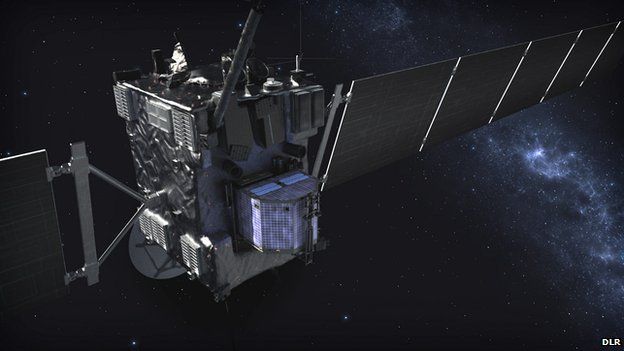Comet lander checks in with Earth
- Published

The Philae lander, which Europe hopes to put on the surface of a comet later this year, has been re-activated after three years in deep-space hibernation.
The small probe is currently riding piggy-back on the Rosetta satellite. This was despatched 10 years ago to rendezvous with the Comet 67P/Churyumov-Gerasimenko, and was itself awoken in January.
"Mothership" and lander should arrive at the huge ice object in August.
After a period of mapping, Rosetta will then release Philae on its challenging bid to attach itself to 67P in November.
Being only 4km across, the comet's gravitational field will be very weak, and the 100kg box of instruments will use harpoons and ice screws to try to hold itself down.
The German space agency (DLR) confirmed receipt of the activation message from Philae just after 1500 Central European Time (1400 GMT).
Philae's wake-up is part of a sequence of commissioning activities taking place over the next few weeks.
The main probe was sent so far from Earth to chase down 67P that it went beyond the distance where solar panels could pick up enough energy to run all onboard systems.
Engineers therefore took the decision to close down operations on the satellite for a period of 31 months.
Now that Rosetta is moving closer to the Sun again, those systems - and, in particular, the various scientific instruments - are all being switched back on, one by one.
Most will be switched straight back off again after an initial health-check because power availability remains constrained in the short-term.
The key exception is Rosetta's imaging system, Osiris. It will stay on because it is needed to help plot the precise position of 67P on the sky.
This leads to the next big event in the mission - the major manoeuvre that will start to refine Rosetta's trajectory to the comet.
This will be initiated on 21 May with a seven-hour, 21-minute burn on the spacecraft's thrusters.
A further eight burns are then planned over the summer, with Rosetta set to go into orbit around 67P in the first week of August.
Earlier this week, the European Space Agency issued the first pictures of 67P acquired by Osiris since its recommissioning.
Rosetta is currently 655 million km from Earth and about 3.8 million km from 67P.
- Published21 March 2014
- Published20 January 2014
- Published10 December 2013
- Published18 September 2013
- Published29 March 2012